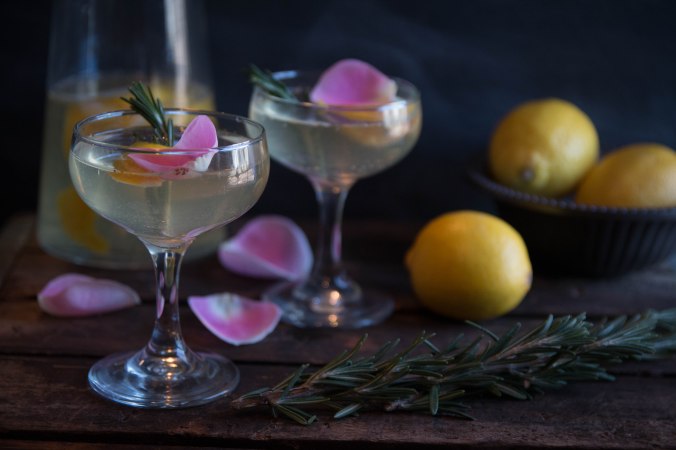
Photo by Carley Storm Photography http://www.carleystormphotography.com
In the heat of the Philadelphia summer, we’ve been on the lookout for refreshing beverage recipes to prepare alongside hearty, early modern fare. “Could Possett,” a boozy herbaceous lemonade, hit the spot.
This recipe comes from UPenn Ms. Codex 252, an all-purpose household manuscript that was in use between 1600 and 1710. Food recipes are intermixed with medicinal recipes throughout the manuscript.
The Recipe
To make Could Possett
Take a pint of white wine a quarter of a pint of the Rose water
4 spounefulles of verges the Juice of one greate lemmon put into and halfe
the yellow rind of that Lemmon put into the Liqour with branch of
Rosemary and alitle amber greese and musk put as much sugar
into this as will sweetten it accordinge to your Likinge stire and
brew these together at Lest a quarter of an hower
Just as Ms Codex 252 is a mix of medicinal and culinary recipes, so too does the “Could Possett” straddle the categories between comestible and cure. In William Shakespeare’s Macbeth, Lady Macbeth informs the audience that she has incapacitated King Duncan’s guards by contaminating their posset: “The surfeted Groomes doe mock their charge / With Snores. I haue drugg’d their Possets” (1623). Robert Herrick’s poem “To Phillis to love and live with him” promises a beloved posset, among other delicacies: “Thou shall have Possets, Wassails fine, / Not made of Ale, but spiced Wine” (1648). The Oxford English Dictionary defines a “posset” as a “drink made from hot milk curdled with ale, wine, or other liquor, flavoured with sugar, herbs, spices, etc., and often drunk for medicinal purposes.” Recipes for “ordinary plain wholesome posset” and “sack posset” in Ms Codex 252 fit this description well. Our “could possett” recipe does not call for hot, curdled milk, but it does bear a resemblance to some of the other medicinal waters in the volume.
This recipe calls for a few relatively exotic ingredients. “Verges,” or “verjuice,” is a sour beverage made from immature grapes that is still available today, but somewhat difficult to find. We found our posset to be quite tart without adding the verjuice. “Amber greese,” or ambergris, and musk are both more associated with scent and perfumery these days than with beverages, although they were widely used in punches and tinctures in the early modern era. We debated adding angostura bitters instead, but decided that the rosemary and rose water were sufficiently flavorful on their own. Since wine was far sweeter in the seventeenth century than it is today, we used a fairly sweet prosecco that we had on hand as as the base alcohol for the drink. It also added some festive bubbles! For a tasty, alcohol-free version of this recipe, substitute a liter of sparkling water, tonic water, or fine ginger ale for the wine and adjust the sugar accordingly.
Our Recipe
serves 8
1 bottle white wine, on the sweet side (still or sparkling)
1/4 cup rose water
juice of one lemon
peel of half a lemon, cut into long strips
4 sprigs of rosemary
1/2 cup sugar (adjust to taste)
Mix the ingredients in a large serving jug or punch bowl. Stir until the sugar dissolves. Taste to check sugar levels and adjust as needed. Allow to sit for 15 minutes before serving.
The Results
A tart, highly quaffable summer beverage. It looks lovely in the glass and stands up to flavorful food. We sipped it alongside Maccarony Cheese and a side of bitter greens. The wine and lemon flavors dominated, while the rosemary and rosewater added fresh, vegetal notes. This is a great recipe for a summer picnic, barbeque, or dinner party.





Reblogged this on DailyHistory.org and commented:
Cooking in the Archives is brand new, but it is already absolutely fabulous. Their most recent recipe is “Could Possett.” It is a mixture of white wine, rose water, lemon, rosemary, sugar, and verjuice. The original recipe also asks for “amber greese or ambergris and musk,” but Marissa Nicosia leaves that out in the updated version. I’m not 100% sure, but if the Amber Geese called for in the recipe is actually Ambergris that would be pretty vile addition to what appears to be a lovely cocktail. Ambergris is the waxy substance from a sperm whale’s digestive system previously used in perfumes.
Thanks for reblogging!
That very same ambergris derived from whales was used in very small quantities in early modern beverages and other comestibles.
Sixteenth-century mixology at its best 😉
Chez Nous restaurant in Lee, Massachusetts has a contemporary possett on its dessert menu.
Pingback: Chery brandy | Cooking in the Archives
Pingback: A tarte of green pease | Cooking in the Archives
Pingback: To presarue Aprecokes | Cooking in the Archives
Pingback: Lemon Posset | Cooking in the Archives
Pingback: Margarett Baker’s sacke possett & fine biskett, or a year with Folger MS V.a.619 | Cooking in the Archives
Pingback: To make Cordial Pepper Water | Cooking in the Archives